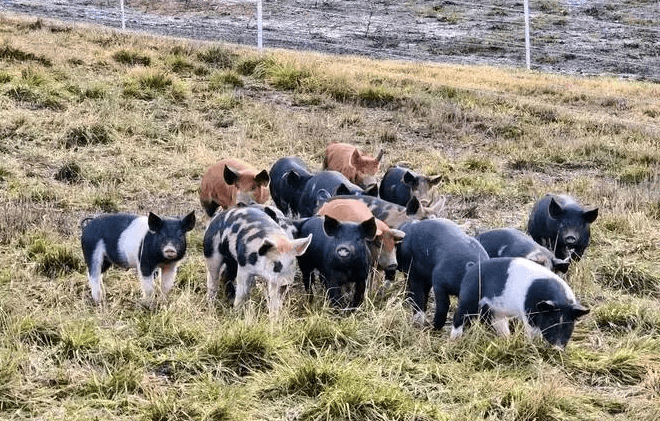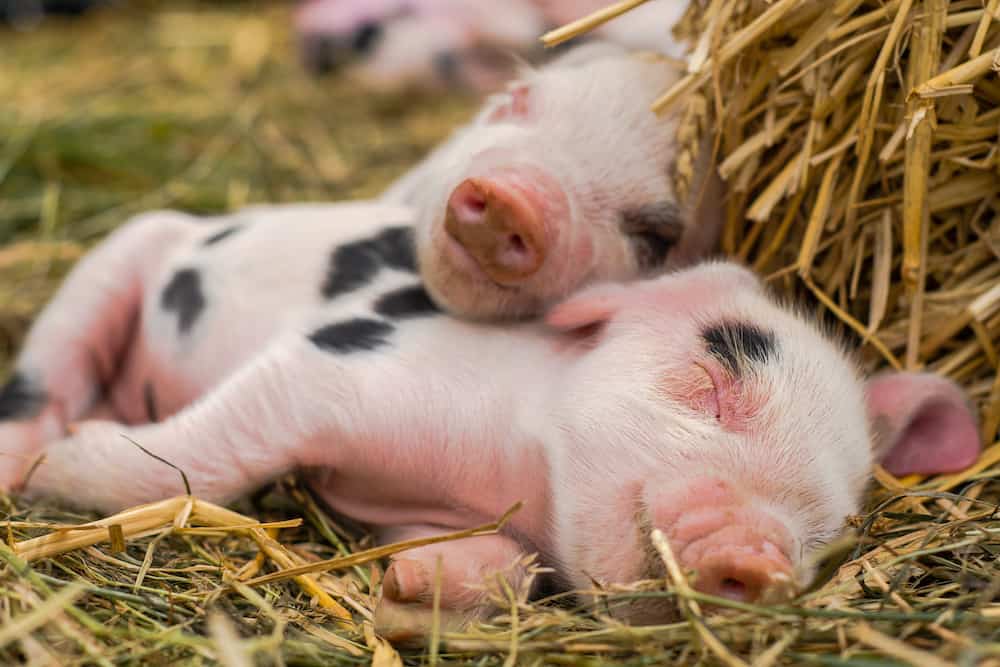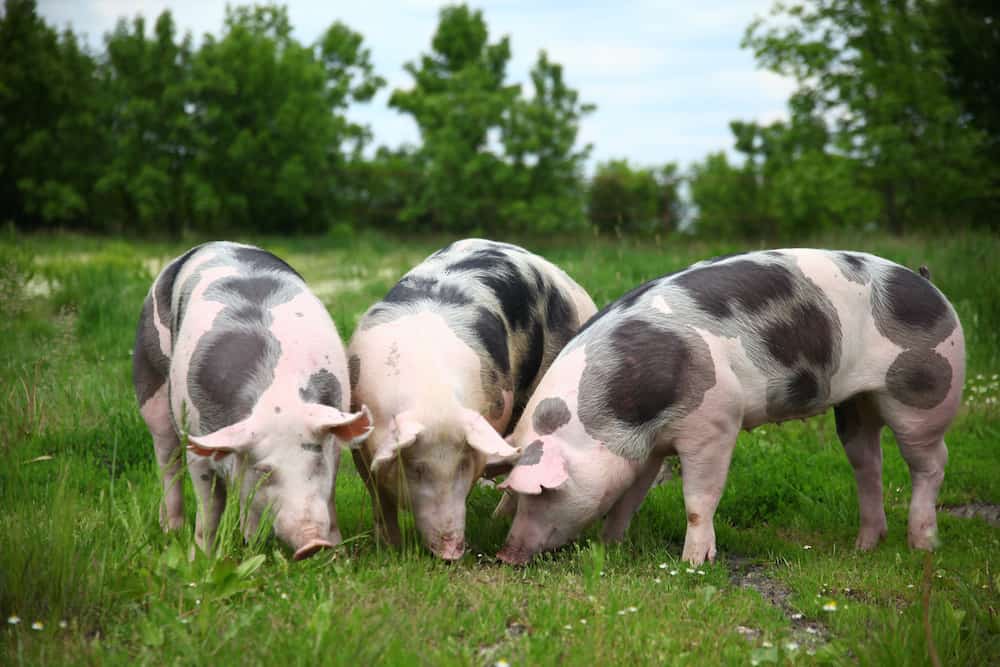There are many pig breeds to consider raising. Whether you have a small hobby farm or are new to the world of homesteading, raising pigs is a satisfying and worthwhile pursuit. When you think about raising livestock, you may want animals to have a protein source. One of the most common is pigs.
Have you ever wondered what the different types of pigs are? Have you ever thought about what are the best pigs for meat? Here we discuss the different pig breeds that any small farmer or beginner homesteader can start with. When done correctly, they will offer a good ROI.
How Many Pig Breeds Are There?
There are hundreds of different types of pigs. They can even be categorized into different species. The domestic pigs that we are familiar with, though, are mostly descended from the wild boar. The breeds below are the pigs we deem best if you are starting out.
11 Great Swine Breeds to Start With
Below are the top 11 choices of pig breeds perfect for beginners, along with the reasons we have chosen each of them.
1. American Yorkshire
This pig breed originated in England and is, thus, also known as the English Large White. American Yorkshire pigs are the most common breed farmed in the United States and Canada.
What we like about this breed is that it produces a substantial amount of lean meat and has a lower amount of back fat than other breeds. Its meat is also often used in making well-textured bacon.
2. Berkshire
This is another breed that originated from England. Today, it can be found bred and farmed in many parts of the globe, including Australia, Japan, New Zealand, and the United States. It is a heritage pig breed and also considered to be a lard pig.
What we like about this breed is its easy-going personality, making it very easy to raise. Overall, Berkshires are one of the most profitable to raise. This is because they grow fast, reproduce well, and have tasty meat. Berkshire meat is marbled. We have also found Berkshire pigs to be more curious and active than others, so you really need to reinforce your fencing.

3. Chester White
If you want to get a strong mother for breeding, then the Chester White is the right breed to go for. This breed is a heritage one that hails from Chester County, Pennsylvania. What we like about Chester White pigs is that they grow quickly. They produce savory meat high in fat.
Because of their pale skin, you’d need to provide shaded areas where they can find refuge from the sun’s rays to avoid sunburn. Chester White pigs are another profitable pig breed to raise.
4. Duroc
Here’s another breed that originated from America. Are Duroc pigs good for meat? Yes! It’s darker red in color, moist, and has fat marbling, all appealing characteristics for pork. Durocs are used for commercial pork production due to its tenderness and flavor.
What we like about this pig breed is that Duroc are very mild-mannered. They are considered to be the among the least aggressive types of pigs raised for meat. These are good pigs for small farmers and beginners. This domestic pig can be either golden-yellow or reddish-brown.
5. Hampshire
The Hampshire pig breed is one of the oldest breeds ever recorded in America. As the name suggests, this also hails from England, but it’s known to have been imported from Scotland, as well. Some pig breeders also know it as the Old English Breed. You can recognize them from the white belt they have around the front of their bodies.
What we like about Hampshire pigs, and probably the reasons it has endured for so long, are its larger loin and a lower amount of back fat compared to other breeds. From a farming perspective, a big advantage to raising Hampshire pigs for meat is they are excellent foragers and overall, very hardy.
In addition, Hampshires provide a good return on investment if you are interested in raising piglets. Learn more about raising a Hampshire pig. They are great for beginner pig owners and those starting out with raising livestock.
6. Hereford
One of the biggest challenges of getting a heritage breed like some of the ones listed above is that they can sometimes be hard to find. Fortunately, the Hereford pig, while also a heritage breed, is easier to procure than others.
We love this pig breed because we have found its high-quality meat to be one of the most delicious. The are good meat hogs to raise because they have an easy-going temperament. What’s more, Hereford pigs can adapt well to most climates, as well as get fat easily, providing a good ROI. Beginner pig raisers would find it easy to care for.
7. Landrace
This breed originated from Denmark. Like the Chester White, it’s another type of pig to get if you want sturdy mothers that produce a lot of milk and large, healthy piglets. They have large litters. In one farrowing, they can have 10+ piglets.
One of the things to like about raising Landrace pigs is that they cross well with other breeds. This means it’s an ideal pig type to raise with other hogs and swine breeds. As far as meat, Landrace pigs provide a high percentage of carcass meat with lean loin and lean ham.
8. Large Black
We are all familiar with pinkish pigs but do not underestimate the Large Black. This pig breed was once the most popular breed in England. This is because Large Black pigs can get really big and produce delicious meats. They are all black, from head to tail.
What we like about Large Blacks is they are extremely hardy. They do well in a wide-range of climates, hot or cold. Consider raising these pigs for meat if you have a large pasture. Large Blacks will thrive as they are excellent grazers and foragers. They provide a good ROI when they are able to graze for long periods. Large Black pigs are also known for their rather extended periods of fertility.
9. Spotted also called Gloucestershire Old Spot (GOS)
GOS is another pig breed that was and is very popular in England. One reason is that the Spotted pig is the breed that the royal family favors for its taste.
We also like that its sows are great mothers and produce larger litters compared to other breeds. They easily adapt to pasture raising. Like with other raising other pigs for meat, consider raising them if you are able to move them around the pasture. Pigs graze, forage, till, and fertilize the soil.
10. Tamworth
This breed of pig might be the smallest on our list, but we love caring for Tamworth due to its lean carcass and excellent foraging ability. As such, you’d want to invest in Tamworth pigs only if you plan on setting up a forage-based farming system.
11. Idaho Pasture Pigs
Small-scale farmers and homesteaders will want to consider raising Idaho Pasture pigs (IPP). This is a new pig breed made up from Duroc, Berkshires, and Kunekune pigs. IPPs are easy to handle with their good-nature. They are also smaller than many other breeds. The Idaho Pasture pig was developed to be a true grazing pig.
These pigs are able to graze on and eat grass rather than rooting it. This is because their snouts are not long and straight. This enables the Idaho Pasture pigs to access the grass differently than other types of pigs. If you are looking for a grazing pig with excellent pasture pork, consider raising IPPs on your farm.
Other Pig Breeds to Consider
Another type of pig for meat to consider raising on your homestead is the Mangalitsa pig and Kunekune pigs. Kunekunes are excellent grazers which means they require less grains to reach market weight than some other pig breeds.

Other Considerations When Raising Pigs
Have you already set your sights on the pig breeds you want to take a closer look at? That’s great! As mentioned, you need to prepare yourself first before taking one (or several) home. Good preparation is the secret to raising happy and healthy pigs.
Here are several considerations to keep in mind before you start your pig raising experience:
1. Shelter
Building an appropriate barn or shed is essential. A pig’s shelter has two components. First is the actual shelter that will protect them from the elements. Second is the ground, surrounded by proper fencing, where they can stroll and wallow. This outdoor space is also essential to give your pigs some space to defecate on.
What a lot of beginner pig raisers, or even some experienced ones, don’t realize is that pigs have actually very clean habits.
For one, they won’t defecate inside their shelter, where they sleep, unless absolutely forced to do so. Instead, the pigs will usually choose a particular spot far away from their sleeping corner.
They also want their bedding dry as much as possible. Straw is the best material to use since it keeps them cool even during warm summer nights.
2. Fencing
As for the fencing for pigs, we recommend installing both a physical fence and an electric fence. Pigs are really smart, so it won’t take them long to realize what the electric fence means and stay away from it. If possible, install it outside of the physical fence to the pigs protection from predators.
When you install an electric fence, you can lessen the wear and tear of your physical fence significantly.
3. Nourishment
A pig needs clean water and food to grow to its potential. Pigs are great foragers, but this doesn’t mean they won’t need feeds. Learning what do pigs eat on the farm will help them reach butcher weight.
To further boost the nutritional benefits of your pig’s diet, give them a selection of vegetable scraps from your garden and leftovers from your meals. Many fruits and vegetables you might otherwise throw away or put in a compost pile you can instead give to pigs. You can also give them freshly baked bread every once in a while.
4. Wallow
Pigs need to wallow in mud to keep themselves cool, especially during the summer months. You can start by giving them a shallow kiddie pool filled with soil and water. Why do pigs like mud
However, they will soon outgrow this space, so you will need to learn how to make a natural wallow for your pigs later on. A perfect area is a depressed part of your property, still near their shelter and food.
Pigs are very expressive. Each has their own personality. If some of their needs are not met, you can be sure that they will find a way to make you realize it somehow, so pay close attention to them as they’re growing up.
5. Breeding pigs
Do you want to raise litters of piglets on your farm? It is important to learn how to breed pigs to keep the desirable traits.
Raising Pigs
Pigs are among the best farm animals to raise and will help you be more sustainable. However, there things to keep in mind before bringing one home.
Pigs are really fast and smart
Be sure to have everything ready, and learn as much as you can before buying pigs. Learn the basics of caring for livestock before bringing them home. Caring for your pigs needs to be a priority. Consider pasture-raised if possible.
You’re not going to raise a pet
You can name your pigs if you want, but when the time comes, the intention of raising them is to have a sustainable lifestyle and benefit from them.
Give them the best life
Make their end swift and painless. The less stressed your pig is, the more nourishment it will provide. Once you decide to slaughter one, don’t waste anything. Give it the respect that it deserves.
FAQs About Pig Breeds
We’ve answered common questions related to the best pig breeds.
1. What is the most common pig breed?
Of all the pig breeds, you might wonder if there’s a more common breed than others or a type people prefer to raise. The most common pig breed actually varies from one location to another. There are a lot of breeds that originated from England. Therefore, there are popular pig breeds there that differ from those in the US.
For North America, the most common pig breed, especially for homesteaders, is the American Yorkshire. These pigs are adaptable, provide excellent meat, and are fairly easy to access.
In other parts of the world, you’d find that homesteaders also prefer Tamworth, Duroc, Hampshire, and Landrace.
2. What breed of pig is best for meat?
If you want to get the best pigs for meat, the best choice are Berkshire pigs and Durocs. Berkshire meat is dark and tasty. They have a 600-pound average weight, and they can easily grow even by just foraging. This means you can get their weight to increase even more with proper care.
Also, they have a very easy-going personality, so keeping them happy and healthy wouldn’t be much of an issue. If there’s one tip that we can give you based on experience raising Berkshires, it’s they can be very sensitive to cold weather. Make sure that the shelter you provide them offers warmth and comfort. If not, they may not grow to their weight potential.
Aside from the Berkshire breed, another best pig for meat is the Duroc. This breed will also yield a lot of delicious meat. Duroc meat is dark red and has good fat marbling. It’s moist and not dry.
3. What breed of pig is best for bacon?
Speaking of delicious meat, how does bacon sound? Bacon is a meat cut that you can get from a pig’s belly or back. You can then cut and cure that meat to extract that juicy flavor you want. To get good cuts for bacon, especially those yummy streaks coming from a balanced amount between lean meat and fat, you’ll want pig breeds with lower amounts of back fat.
There many pig breeds to consider to get good bacon, including American Yorkshire, Tamworth, Large Black, and Landrace.
4. Which breed of pig is most profitable?
According to pork.org, the pig breed that’s most profitable is the Berkshire. This is followed by Chester Whites and Durocs. Many families take on raising these breeds for 4-H and FFA.
5. What is the difference between pigs and hogs?
When you are considering pig breeds or hog breeds, they are the same thing. People often refer to domesticated pigs as hogs when they are over 120 pounds.
Pig Breeds for Raising
There are different pig breeds you can choose to raise, and each one has its own temperament, specific needs, and preferences. Be sure to get a breed that will produce good meat, especially bacon.
You also need to consider certain factors before you decide on one in particular. These factors include the space you have for decent shelter, nourishing food and clean water, and a cool, spacious, wallow. Consider if you are set up for breeding pigs to have a sustainable supply of meat.

